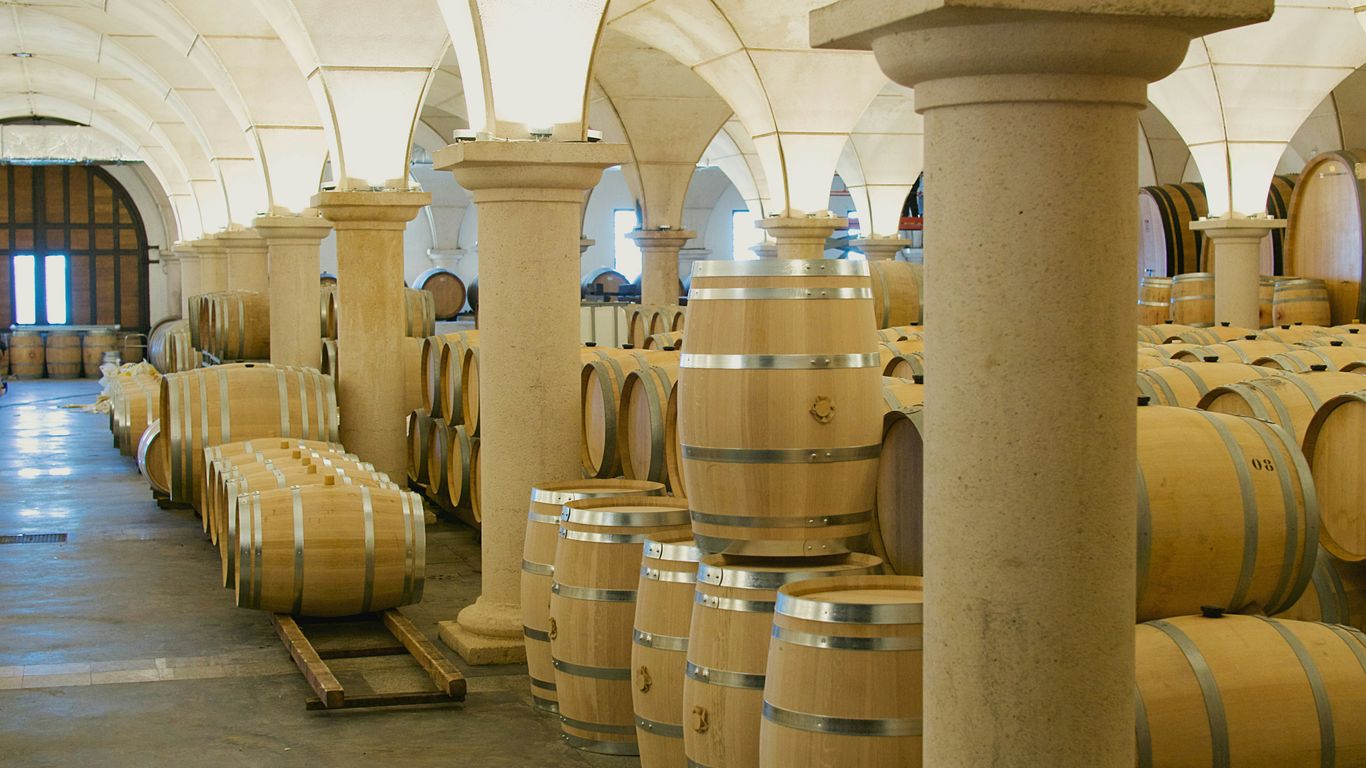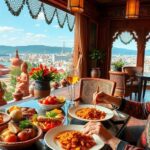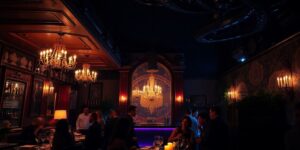Thinking about a trip to Bordeaux? It’s a place that really knows its wine, and the châteaux there are something else. Imagine walking through historic estates, learning about how they make their famous wines, and even getting to taste them right from the barrel. It’s not just about drinking wine; it’s about experiencing the whole story behind it. From the old traditions to the new ways of making wine, Bordeaux Wine Châteaux offer a look into a world of luxury and flavor.
Key Takeaways
- Experiencing Bordeaux Wine Châteaux offers an intimate look into the winemaking process, including curator-led barrel tastings.
- Understanding Bordeaux’s appellation system and terroir is key to appreciating the unique qualities of different châteaux.
- Iconic Bordeaux Wine Châteaux like Margaux, Lafite Rothschild, and Cheval Blanc provide distinct and memorable tasting experiences.
- The aging process in oak barrels, grape varietals, and vintage years all play a significant role in the final taste of Bordeaux wines.
- Visiting Bordeaux Wine Châteaux can be a luxurious affair, with options for bespoke tours, private tastings, and stays amidst the vineyards.
Discovering Premier Cru Bordeaux Wine Châteaux
When you think of Bordeaux, you probably picture those grand estates, the ones with the fancy names that have been around forever. These aren’t just any wineries; they’re the heart of what makes Bordeaux wine so special. We’re talking about the Premier Cru estates, the top tier, the ones that have earned their reputation over centuries. It’s a world steeped in history and tradition, where the land itself seems to whisper tales of past vintages.
The Legacy of Historic Bordeaux Estates
These châteaux aren’t just buildings; they’re living monuments. Many have been in the same families for generations, passing down not just the land but a deep-seated knowledge of winemaking. Think of it like a family recipe, perfected over hundreds of years. This continuity is a big part of what gives these wines their unique character. The history is literally in the bottle.
Understanding Bordeaux’s Appellation System
Bordeaux has a system, and it’s pretty important for understanding what you’re drinking. It’s all about rules that protect the name and quality of the wine. Basically, an appellation tells you where the grapes came from and how the wine was made. It’s a way to ensure you’re getting a genuine Bordeaux experience.
- Médoc: Known for its powerful red wines, especially Cabernet Sauvignon blends.
- Saint-Émilion: Famous for its Merlot-dominant reds, often with a softer, more approachable style.
- Pomerol: Home to some of the most sought-after wines, also typically Merlot-based and rich.
- Graves: Produces both reds and whites, with a reputation for elegance.
Exploring the Terroir of Renowned Châteaux
Terroir is a fancy word, but it’s super important. It means the combination of soil, climate, and geography that makes a wine taste the way it does. In Bordeaux, the specific plots of land where these top châteaux grow their grapes are incredibly special. They have the right mix of gravel, clay, and sand, plus the perfect amount of sunshine and rain. It’s this terroir that gives each wine its distinct flavor profile, something you can’t replicate anywhere else.
The idea that a specific patch of earth can produce something so complex and wonderful is pretty amazing. It’s not just about the grapes; it’s about the whole environment working together.
Curator-Led Barrel Tastings at Bordeaux Wine Châteaux
An Intimate Glimpse into Winemaking
Forget the standard tour; this is where you get to see the real work happening. A curator-led barrel tasting isn’t just about sipping wine; it’s about stepping right into the heart of the winemaking process. You’ll be standing among the barrels, often in the cool, quiet cellars, getting a feel for the environment where the magic truly happens. This is your chance to connect with the wine on a much deeper level. It’s a more personal experience, where you can ask questions and really understand the decisions being made at each step.
Direct from the Cellar: Unfiltered Flavors
When you taste wine straight from the barrel, it’s a completely different ballgame. This is wine before it’s been filtered or potentially changed by bottling. You’re tasting the raw, unadulterated essence of the grape and the oak. It’s a snapshot of the wine in its youth, showing its potential and character before it’s fully developed. You might notice tannins that are still a bit rough, or fruit flavors that are incredibly vibrant. It’s a look at the wine’s journey, not just its final destination.
The Art of Blending: A Curator’s Perspective
One of the most fascinating parts of a curator-led tasting is understanding the art of blending. In Bordeaux, especially at the top châteaux, blending is key to creating that signature style. The curator will often pull samples from different barrels, perhaps from different grape varietals or different parts of the vineyard. They’ll explain why they might combine certain lots and what they’re trying to achieve. It’s like a chef explaining how they combine ingredients to create a complex dish.
Here’s a look at what you might experience:
- Sampling from various oak types: See how French oak, American oak, or even different toast levels affect the wine.
- Tasting different grape varietals: Understand the contribution of Merlot, Cabernet Sauvignon, Cabernet Franc, and others before they are combined.
- Comparing vineyard plots: Some curators might even let you taste wines from specific parcels of land to highlight the impact of terroir.
This kind of tasting offers a unique educational opportunity. It’s not just about enjoying a drink; it’s about appreciating the skill, the science, and the tradition that goes into every bottle. You leave with a newfound respect for the complexity of winemaking.
| Component | Description |
|---|---|
| Wine Stage | Directly from barrel, pre-bottling |
| Flavor Profile | Often more intense, raw tannins, vibrant fruit |
| Focus | Winemaking process, blending, terroir |
| Experience | Intimate, educational, direct connection |
Iconic Bordeaux Wine Châteaux Experiences
When you think of Bordeaux, certain names just pop into your head, right? These are the places that have been making wine for ages, building up a reputation that’s pretty hard to beat. Visiting them isn’t just about tasting wine; it’s like stepping into a piece of history. We’re talking about estates that are practically legends in the wine world.
Château Margaux: Elegance in Every Sip
Château Margaux is often described as the epitome of grace. It’s one of those First Growths that just has this undeniable finesse. The wines here are known for being incredibly perfumed, with a silky texture that’s just a dream. It’s not a loud wine; it’s more of a whisper that commands your attention. Think delicate floral notes, ripe berries, and a finish that seems to go on forever. It’s the kind of wine that makes you pause and really appreciate the moment.
Château Lafite Rothschild: A Timeless Classic
Château Lafite Rothschild is another name that carries immense weight. It’s a benchmark for what Bordeaux can be. The wines are powerful yet balanced, with a distinct character that many try to emulate but few can match. You’ll often find notes of cedar, blackcurrant, and a certain earthiness that speaks to its long history and terroir. It’s a wine that ages beautifully, evolving in the bottle for decades, becoming more complex and profound with time. It truly is a timeless classic that collectors and enthusiasts alike strive to experience.
Château Cheval Blanc: The Pinnacle of Blending
Château Cheval Blanc, meaning ‘White Horse’, is unique because it’s one of the few Saint-Émilion estates to achieve Premier Grand Cru Classé ‘A’ status. What sets it apart is its blend, which often includes a higher percentage of Cabernet Franc than is typical for the region. This gives its wines a distinctive aromatic profile, often featuring notes of violets, ripe plum, and spice, alongside a remarkable freshness and structure. It’s a wine that showcases the art of blending, creating something truly special that stands out even in the esteemed company of Bordeaux’s top wines. Experiencing Cheval Blanc is understanding how different grape varietals can come together to create pure magic.
Unveiling the Secrets of Bordeaux Wine Châteaux
The Influence of Oak Barrels on Aging
Ever wonder why some wines just taste… richer? A lot of that comes down to the barrels. In Bordeaux, oak barrels aren’t just containers; they’re active participants in the wine’s journey. New oak, especially, imparts flavors like vanilla, toast, and spice. It also lets a little bit of air in, which helps the wine mature and soften over time. The type of oak matters too – French oak is the classic choice for Bordeaux, giving it that signature elegance.
Here’s a quick look at how barrel aging can change a wine:
| Barrel Type | Flavor Impact | Tannin Impact | Aging Potential |
|---|---|---|---|
| New French Oak | Vanilla, toast, spice | Adds structure | High |
| Used French Oak | Subtle wood notes | Softens tannins | Medium |
| American Oak | Coconut, dill | Can be strong | Varies |
Grape Varietals and Their Expression
Bordeaux is famous for its blends, and that’s because different grapes bring different things to the party. Cabernet Sauvignon is the backbone, giving structure and dark fruit flavors. Merlot adds softness and plum notes. Cabernet Franc brings floral and earthy hints, while Petit Verdot and Malbec contribute color and spice. The magic happens when the winemakers skillfully combine these grapes.
Think of it like this:
- Cabernet Sauvignon: The strong, silent type, providing power and longevity.
- Merlot: The smooth talker, adding approachability and fruitiness.
- Cabernet Franc: The aromatic one, with its unique herbal and floral notes.
- Petit Verdot & Malbec: The supporting cast, adding depth and complexity.
The Role of Vintage in Bordeaux Wines
No two years are exactly alike in Bordeaux, and that’s a good thing! The weather each year – the amount of sun, rain, and temperature fluctuations – directly impacts the grapes. A warm, sunny year might produce riper, bolder wines, while a cooler year could result in more delicate, acidic wines. Understanding the vintage is key to appreciating why a particular bottle tastes the way it does. Experienced collectors often seek out specific years that are known for producing exceptional wines.
The subtle differences from one year to the next are what make collecting Bordeaux so fascinating. It’s a liquid history book, with each vintage telling the story of its growing season.
Exclusive Access to Bordeaux Wine Châteaux
Bespoke Tours for Discerning Travelers
Forget the standard group tours. When you’re looking for something special, many châteaux now offer private tours tailored just for you. This means you get to see parts of the estate that aren’t usually open to the public. Think private cellars, historic barrel rooms, and maybe even a chat with the vineyard manager. It’s about experiencing the château at your own pace. These tours often include a more in-depth look at the winemaking process, from the vineyard to the bottle. You might even get to walk through rows of vines that are centuries old, learning about the specific terroir that makes Bordeaux so famous.
Private Tastings Beyond the Public Eye
This is where things get really interesting. Instead of a quick tasting with a crowd, imagine a private session where you can really focus on the wine. Many estates will arrange special tastings for smaller groups, often in unique settings like a private tasting room or even a quiet corner of the aging cellar. You’ll get to sample wines that might not be available in the main tasting room, sometimes even pre-release bottles or special library releases. It’s a chance to really connect with the wine and the people who make it.
Here’s a peek at what a private tasting might include:
- Welcome drink: Often a glass of the château’s sparkling Crémant de Bordeaux or a crisp white.
- Core tasting: A selection of the estate’s current releases, allowing for detailed discussion.
- Special pour: A taste of a premium Grand Cru Classé or a library wine.
- Q&A: Dedicated time to ask the winemaker or tasting guide your burning questions.
Luxury Accommodations Amidst Vineyards
Why just visit when you can stay? Several Bordeaux châteaux have opened their doors to guests, offering luxurious accommodations right on the estate. Waking up surrounded by rolling vineyards is an experience in itself. You’ll be treated to top-notch service, often with gourmet meals prepared using local ingredients, paired, of course, with the château’s own wines. It’s the ultimate way to immerse yourself in the Bordeaux lifestyle.
Staying at a château isn’t just about a place to sleep; it’s about living the wine country dream. You get a sense of the history and the daily life of the estate in a way that a day trip just can’t provide. It’s a chance to slow down and truly appreciate the beauty and the craft of Bordeaux.
Some estates even offer:
- Vineyard walks and bike tours.
- Cooking classes focusing on regional cuisine.
- Exclusive access to château events or harvest activities (depending on the season).
This level of access transforms a simple visit into a memorable, deeply personal journey into the heart of Bordeaux wine country.
The Art of Wine Appreciation at Bordeaux Châteaux

Appreciating Bordeaux wine goes beyond just tasting; it’s about connecting with the land, the history, and the craft. When you’re at a château, especially during a curator-led barrel tasting, you get a real sense of what makes these wines so special. It’s not just about the final bottle; it’s the whole journey from the soil to the glass.
Developing Your Palate for Fine Wines
Learning to taste wine like a pro takes a little practice, but it’s totally doable. Think of it like learning to appreciate any complex food or drink. You start by paying attention to the basics: the color, the smell, and then, of course, the taste. What flavors do you pick up? Are they fruity, earthy, spicy? How does it feel in your mouth – is it smooth, rough, light, or heavy? Don’t worry if you don’t get it right away. Everyone’s palate is different, and that’s part of the fun.
Here’s a simple way to start thinking about what you’re tasting:
- Appearance: Look at the wine’s color. Is it deep red, light ruby, or something else? This can tell you about the grape and how old the wine might be.
- Aroma: Swirl the wine in your glass and take a good sniff. What do you smell? Fruits like cherry or blackcurrant? Maybe some oak, vanilla, or even a hint of leather?
- Taste: Take a sip and let it sit in your mouth for a moment. Notice the flavors. How is the acidity (that tartness)? How about the tannins (that drying sensation, especially in red wines)? How long do the flavors stick around after you swallow?
- Finish: How does the wine feel and taste after you’ve swallowed? Is it pleasant and long-lasting, or does it fade quickly?
The Nuances of Terroir and Winemaking
Terroir is a big word in the wine world, and it basically means the environment where the grapes are grown. This includes everything: the soil, the climate, the slope of the land, and even how the vines are planted. Different spots on a single château’s property can produce grapes that taste quite different. Winemakers then take these grapes and use their skills to create the final wine. They decide when to pick the grapes, how to ferment them, and how long to age them in barrels. It’s a mix of nature and human touch.
Think about it like this:
- Soil Composition: The minerals and structure of the soil directly affect the grape’s flavor. Some soils might give wines a minerality, while others contribute to fruitiness.
- Climate: Sunshine, rain, and temperature all play a role. Warmer climates tend to produce riper grapes with more intense flavors, while cooler climates can lead to more delicate, acidic wines.
- Winemaker’s Choices: From the type of oak barrel used for aging to the decision of when to bottle, the winemaker’s decisions shape the wine’s character.
Connecting with the History of Bordeaux Wines
When you taste a wine from a historic Bordeaux château, you’re not just tasting grapes; you’re tasting history. These estates have been making wine for centuries, passing down knowledge and traditions from one generation to the next. Each bottle carries a story of the land, the people who worked it, and the specific year the grapes were grown. It’s a connection to the past that you can literally taste. Understanding this lineage adds a whole new layer to the enjoyment of fine wine.
The journey of a wine from vineyard to bottle is a long and intricate process, deeply tied to the land and the seasons. Each element, from the soil’s composition to the winemaker’s careful decisions, contributes to the final character of the wine. Appreciating this complexity allows for a richer tasting experience, connecting the drinker to the heritage and artistry involved.
Beyond the Tasting Room: Bordeaux Wine Châteaux
Sure, tasting the wine is the main event, but there’s so much more to see and do at these incredible Bordeaux estates. It’s not just about what’s in the glass; it’s about the whole picture. Think about the buildings themselves – some of these châteaux are like living museums, with architecture that tells a story going back centuries. And then there’s the food. You can’t really talk about Bordeaux without talking about the amazing local food, and pairing it with the wine is a whole experience in itself.
Architectural Marvels of the Estates
When you visit a Bordeaux château, you’re stepping into history. Many of these places aren’t just wineries; they’re grand estates with buildings that have stood for hundreds of years. You’ll see everything from classic French Renaissance styles to more modern, sleek designs, all set against the backdrop of rolling vineyards. It’s pretty cool to walk around and imagine all the generations that have worked and lived there. Some have these amazing courtyards, others have towers, and you can really feel the weight of history.
Gastronomic Pairings with Local Cuisine
Bordeaux isn’t just about wine; it’s a foodie paradise too. The region is known for its rich, hearty dishes that go perfectly with their famous wines. Think duck confit, hearty stews, and fresh seafood from the nearby coast. Many châteaux now offer food experiences, from casual lunches to full-on gourmet meals, all designed to complement their wines. It’s a chance to really taste the terroir of the region, not just in the wine, but on your plate too. They often use local ingredients, so you’re getting a true taste of Southwest France.
The Cultural Landscape of Bordeaux
Visiting a château is more than just a wine tour; it’s an immersion into a whole way of life. Bordeaux has a deep cultural connection to wine that goes back centuries. You’ll see how this tradition is passed down, from the vineyard workers to the winemakers. It’s a chance to connect with the history and the people who make these world-renowned wines. You might even catch a local festival or market happening nearby, giving you an even fuller picture of life in this special part of France. It’s a journey that engages all your senses.
Here’s a quick look at what you might experience:
- Historic Architecture: Explore centuries-old buildings, from grand manor houses to functional cellars.
- Regional Flavors: Indulge in local specialties like foie gras, oysters, and Bordelaise sauce.
- Vineyard Views: Enjoy the stunning scenery that has shaped the wine for generations.
- Local Life: Get a feel for the rhythm of the region beyond the château walls.
Planning Your Bordeaux Wine Châteaux Journey
Thinking about a trip to Bordeaux to see some of those famous wine places? It’s a fantastic idea, but getting there and making the most of it takes a little thought. You don’t want to just show up and hope for the best, right? A bit of planning goes a long way to making sure you have a truly memorable experience.
Best Times to Visit for Optimal Experiences
When you plan your visit really matters. The weather plays a big part in how enjoyable your trip will be, and it also affects what’s happening at the vineyards. Spring (April to June) is lovely, with the vines starting to bud and the countryside looking fresh and green. It’s usually not too crowded yet, either. Summer (July to August) is warm, perfect for enjoying the outdoors, but it can get quite busy with tourists. Autumn (September to October) is harvest season, which is super exciting to witness. The leaves change color, and there’s a real buzz in the air. Plus, the weather is often still quite pleasant. Winter (November to March) is quieter, and while some châteaux might have reduced hours or be closed, it’s a good time for a more relaxed, intimate experience if you don’t mind cooler weather.
Navigating Transportation and Logistics
Getting around Bordeaux and its wine regions is pretty straightforward, but you’ll want to figure out your best options. Renting a car gives you the most freedom to explore at your own pace, especially if you plan to visit châteaux that are a bit off the beaten path. Just remember that driving after wine tastings isn’t an option, so you’ll need a designated driver or plan for taxis. Public transport is available, with trains connecting major towns and buses serving some of the smaller villages. For a more relaxed approach, consider organized tours or hiring a private driver. This takes the stress out of driving and parking, and your driver can often offer local insights.
Curating Your Personal Wine Itinerary
This is where the fun really begins! Think about what you want to get out of your trip. Are you interested in the big, famous names, or do you prefer discovering smaller, family-run estates? Do you want to focus on specific types of wine, like reds or whites? It’s a good idea to book tastings and tours in advance, especially for the more popular châteaux. Many places offer different levels of experiences, from a standard tasting to more in-depth cellar tours and barrel tastings. Don’t try to cram too much into one day; Bordeaux is best savored slowly. Give yourself time to enjoy each visit and soak in the atmosphere.
Planning ahead helps you avoid disappointment and ensures you get to experience the châteaux and activities that truly interest you. It’s about creating a journey that feels right for you, not just ticking boxes.
Here’s a quick look at what you might consider when planning:
- Research Châteaux: Look into their history, wine styles, and what kind of visitor experiences they offer.
- Book in Advance: Especially for popular estates and private tastings.
- Consider Location: Group visits by region to minimize travel time.
- Factor in Travel Time: Don’t underestimate how long it takes to get between places.
- Allow for Downtime: Schedule in time to relax and enjoy the scenery.
The Future of Bordeaux Wine Châteaux Experiences
The world of Bordeaux wine châteaux is always changing, and that’s a good thing. It means these historic places are looking ahead, not just resting on their laurels. We’re seeing a real push towards more sustainable farming, which is great for the land and for the wine in the long run. Think about it: less chemical intervention, more focus on the natural health of the soil. It’s a big shift, but one that many estates are embracing.
Sustainable Practices in Viticulture
Many châteaux are now seriously looking at how they farm. This isn’t just about being trendy; it’s about making sure the land can keep producing amazing grapes for generations. You’ll find more organic and biodynamic approaches popping up. This means fewer pesticides, more cover crops to keep the soil healthy, and a general respect for the vineyard’s ecosystem. It’s a complex process, but the goal is simple: healthier vines, better grapes, and ultimately, a more authentic expression of the terroir.
Innovations in Winemaking Techniques
Winemaking itself is evolving. While tradition is key in Bordeaux, there’s also room for smart new ideas. Some estates are experimenting with different types of fermentation vessels, like concrete or amphora, alongside the classic oak barrels. Others are using advanced technology to monitor vineyard conditions and grape ripeness with incredible precision. This blend of old and new is what keeps Bordeaux exciting. It allows winemakers to fine-tune their craft and adapt to changing climates and consumer tastes.
Evolving Visitor Engagement
Châteaux are also rethinking how visitors experience their estates. It’s not just about a quick tasting anymore. We’re seeing more immersive experiences, like hands-on workshops, behind-the-scenes tours that go deeper into the cellar, and even opportunities to participate in harvest activities. The aim is to give people a more personal connection to the wine and the people who make it. It’s about sharing the passion and the hard work that goes into every bottle.
Here’s a look at some of the shifts you might notice:
- Increased use of renewable energy sources on estates.
- More focus on water conservation in vineyard management.
- Development of educational programs about sustainable winegrowing.
- Greater transparency in reporting environmental impact.
The future of Bordeaux is about respecting its rich past while boldly stepping into new territory. It’s a delicate balance, but one that promises even more exceptional wines and memorable experiences for visitors.
Imagine visiting a French wine estate, but with a twist! Bordeaux’s famous wine castles are now offering amazing new ways to experience their vineyards and wines. You can learn about winemaking, taste delicious drinks, and even stay overnight in beautiful settings. Ready to explore these unique wine adventures? Visit our website to discover the best Bordeaux château experiences and plan your unforgettable trip today!
A Taste of History, A Sip of the Future
So, after exploring these incredible Bordeaux châteaux and getting to taste directly from the barrels with the curators, it’s clear this is more than just a wine tour. It’s a chance to really connect with the land and the people who make these famous wines. You get to see where the magic happens, understand the process, and taste the wine at a stage most people never experience. It’s a pretty special way to appreciate what goes into every bottle. If you’re looking for a trip that’s both educational and incredibly enjoyable, this kind of curated barrel tasting experience in Bordeaux is definitely something to consider. You’ll leave with a much deeper appreciation for the wine and the rich history behind it.
Frequently Asked Questions
What makes Bordeaux wines so special?
Bordeaux wines are famous because they come from a special region in France with unique soil and weather. The winemakers there have been making wine for a very long time, and they use special grapes and methods to create amazing flavors that people all over the world love.
What is a ‘Château’ in Bordeaux?
A ‘Château’ is like a wine castle! It’s a place that owns vineyards and makes its own wine. Many of these places have been around for hundreds of years and have cool old buildings and lots of history.
What’s a barrel tasting?
Imagine tasting wine right from the big wooden barrels where it’s aging! A curator-led barrel tasting means an expert guides you through tasting wines straight from the barrel. It’s a rare chance to taste the wine before it’s finished and bottled, giving you a real peek into how it’s made.
Why are some Bordeaux wines so expensive?
Some Bordeaux wines are pricey because they are made by famous Châteaux with a long history of making top-quality wines. The best wines are made in small amounts, using special grapes and careful winemaking, which makes them rare and highly sought after.
What’s the difference between the Left Bank and Right Bank in Bordeaux?
Bordeaux is split by a river. The Left Bank is known for wines made with Cabernet Sauvignon, which often taste bolder. The Right Bank usually makes wines with Merlot, which can be softer and fruitier. Both are delicious in their own way!
How does oak aging affect wine?
When wine sits in oak barrels, it picks up flavors from the wood, like vanilla or spice. It also helps the wine become smoother and age better over time. It’s like giving the wine a special hug from the oak!
What does ‘vintage’ mean for wine?
The ‘vintage’ is simply the year the grapes were grown and harvested. Different years have different weather, so the wine from one year can taste quite different from the wine made the next year. Some years are better for wine than others.
Can I visit a Bordeaux Château even if I’m not a wine expert?
Absolutely! Many Châteaux welcome visitors who are curious about wine. You don’t need to be an expert. Guided tours and tastings are often designed for everyone to enjoy and learn something new about wine and the beautiful estates.











